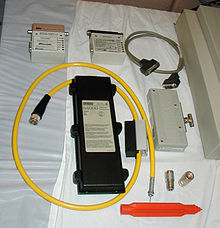|
Medium Attachment Unit
     A Medium Attachment Unit (MAU) is a transceiver which converts signals on an Ethernet cable to and from Attachment Unit Interface (AUI) signals. On original 10BASE5 (thicknet) Ethernet equipment, the MAU was typically clamped to the Ethernet wire via a vampire tap and connected by a multi-wire cable to the computer via a DA-15 port, which was also present on the network interface controller (NIC). This AUI cable could be up to 50 metres (160 ft) long, but was typically much shorter. With later standards, thicknet vampire taps and N connectors gave way to BNC connectors (for thinnet coax cables) and 8P8C connectors (for twisted-pair cables). MAUs for these were still connected to NICs via AUI cables, but soon the MAU ceased to be a separate adapter and was generally integrated into the NIC. Eventually, the entire Ethernet controller was often integrated into a single integrated circuit (chip) to reduce cost. In most modern switched or hubbed Ethernet over twisted pair systems, neither the MAU nor the AUI interfaces exist (apart, perhaps as notional entities for the purposes of thinking about layering the interface), and the category 5 (CAT5) (or better) cable connects directly into an Ethernet socket on the host or router. For backward compatibility with equipment that still had external AUI interfaces only, adapter-type MAUs with 10BASE2 or 10BASE-T connectors long remained available after the obsolescence of original vampire tap MAUs, but even adapter-type MAUs have become very rare as of the 2020s. Similar equipmentThe original Ethernet's successor standard, Fast Ethernet, introduced division into medium access control (MAC) and physical (PHY) layers connected with media-independent interface (MII). Some early Fast Ethernet hardware had physical external MII connectors, functionally similar to the AUI connector, but generally separate adaptors became obsolete. However, the tradition of using a separate low-level I/O device in networking has continued in fast optical fiber network interfaces, where the GBIC, XENPAK, XFP, and enhanced small form-factor pluggable (SFP+) pluggable transceiver modules using the XAUI interface play a similar role. The main difference between AUI and MII is that the AUI deals with line-coded signals, which is specific to the physical medium (10BASE5, 10BASE2 and 10BASE-T all use the same line code), while MII is genuinely media-independent. So while MII and AUI as external connections were similar from a user's point of view, in terms of signalling the equivalent of MII for classic Ethernet were the non-standardized interfaces between MAC and Serial Interface as found in e.g. the Am7990 family. ObjectivesThe purpose of a MAU is to provide the physical means for communication between local network data link entities. As a physical interface, an MAU can be implemented independently among different hardware manufacturers and achieve the intended level of compatibility when interconnected in a common local network. It also allows for ease of installation and service. MAUs provide an easily accessible communication channel capable of high bandwidth and low bit error ratio performance, at relatively low cost. CharacteristicsMAUs support message traffic at a data rate of 10, 100, or even 1000 Mbit/s. They can provide for driving up to 500m of coaxial trunk cable without the use of a repeater. Additionally, a MAU:
Services provided by MAUsIn addition to receiving and transmitting network data, MAUs perform jabber detection, in which they remove from the network any node that continuously transmits for longer than the maximum-length packet. This is done to prevent network disruption. Jabbering indicates a possible problem with the node's NIC. MAUs also help troubleshoot problems with signal quality and integrity. They can test for signal quality errors, which can detect silent failures in the circuitry, as well as perform link integrity functions, which can detect breaks in wire pairs. Both these tests assist in fault isolation. Collision detection and loop-back functions direct transfer through the MAU. Two modes of operationIn normal mode, the MAU functions as a direct connection between the baseband medium and the data terminal equipment (DTE), enabling message traffic between stations. Data output from the DTE is output to the coaxial trunk medium and all data on the coaxial trunk medium is input to the DTE. In monitor mode or isolated mode, the MAU functions as a receive-only connection between the baseband medium and the DTE. Data output from the DTE is suppressed and only data on the coaxial trunk medium is input to the DTE. This mode is for observing message traffic. Functional specifications
References
|
Portal di Ensiklopedia Dunia